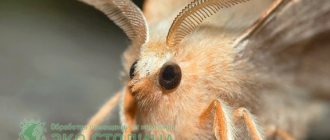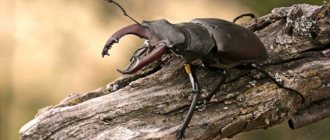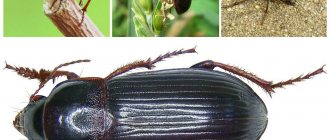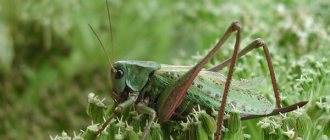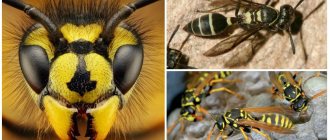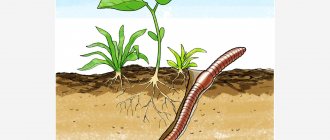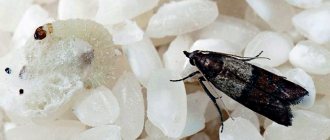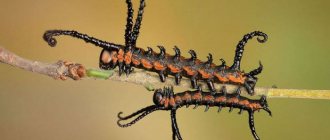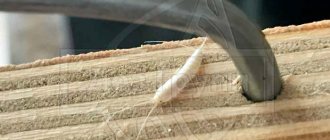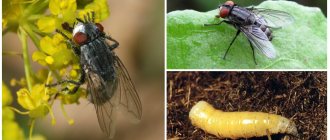Description and appearance
The wasp belongs to the suborder of the stalked bellies, the order of Hymenoptera. Scientists have still not been able to determine which class these insects belong to, so all stinging representatives of stalked bellies that do not belong to ants and bees are called wasps. There are many varieties of wasps, but there is no strict classification of this variety.
The sizes of wasps vary depending on the species, but the appearance and body structure of all members of the family are similar. A wasp is an insect with a characteristic, well-recognized, bright color. It combines two contrasting colors - black and yellow (orange). A pattern on the body in the form of spots and alternating transverse stripes.
Appearance
The size of an adult wasp can reach 12 – 14 mm in males and 18 mm in females. Representatives of certain varieties (most often living in the tropics) are much larger, they grow up to 5.5 cm.
The insect's body consists of a head, thorax and abdomen. A special feature of the body structure of the wasp is a thin membrane connecting the chest and abdomen. Thanks to it, the insect is very mobile and can practically fold in half. There are 6 legs on the chest, each of which consists of 5 segments. 2 pairs of transparent wings, the front ones being slightly longer. The abdomen of 6 segments ends with a sharp, smooth sting. The sting is connected to a gland that produces a poisonous substance.
The wasp's head is quite large. It contains antennae, eyes and mouthparts in the form of powerful jaws. In addition to two large bulging eyes, the wasp also has 3 small simple eyes. The main eyes are made up of several thousand tiny facets. Each of them captures a small part of the image, so the wasp sees the overall picture as a mosaic consisting of many pieces. Thanks to this structure and location of the eyes, the wasp’s visual angle is 280⁰.
Classification and features
The largest habitats of the insect are in Europe, Australia, Argentina, Mexico, and they live in large colonies in Canada and North Africa. They are completely absent in the polar latitudes, and you will not find them in the deserts of the Arabian Peninsula. Residents of the hot Sahara also know nothing about wasps. The population of our country is not only well aware of them, but also often has to fight them. Since, by setting up its nests near housing, the stinging aggressor poses a certain threat to human health.
Species, their description and habits
Scientists are still debating the classification of these amazing representatives of the fauna, unconditionally singling out social representatives and those who prefer to live alone.
The latter include such families as:
- Road
- Germans
- Floral
- Scolia
- Sparkles
- Typhia.
Paper wasps predominate in our country. Everyone has heard about these wasps, and many have even been bitten by them. It is unlikely that you will be able to find anyone who has not seen these insects, which have a recognizable yellow-black color. They build their nests in a round shape in attics or walls of houses.
Paper wasp: it turns out that they are very useful for the vegetable garden, they catch caterpillars and feed their larvae with them.
To construct them, wasps use paper that they themselves produce. Insects obtain their building material by chewing wood, gluing its fibers with saliva.
By crushing these slivers in her mouth and moistening them with saliva, she makes a small lump of paper, albeit of low quality.
The structure of the paper wasp, like other representatives of this family, is quite simple in appearance and consists of three clearly visible segments:
- Head.
- Breast.
- Abdomen.
The body has an external chitinous skeleton. The insect's head is very mobile. It has two antennae. Each antennae performs many functions: from capturing odors to assessing the taste of food. The whiskers also serve to measure the length of the comb when building a nest.
The main difference between a wasp and a hornet is its size
The body length of striped flying predators averages 2 centimeters, and of hornets - up to 3.5 cm. There are two pairs of membranous wings. I wonder how many eyes a wasp has. There are five of them. The wasp's two large eyes are located on the sides of its head and consist of many facets that fit tightly together and form a pattern that looks like a honeycomb. These complex organs of vision make it possible to look in several directions at once. And although it is impossible to focus them exactly, they perfectly capture any movement. In addition, insects such as wasps have three more eyes located on the top of their heads. They, unlike the side ones, have one large pupil.
Wasps diet
The diet of insects is very diverse and largely depends on the species. Nature has endowed them with powerful jaws, which serve both to deal with prey and to feed on plants. Since wasps are aggressive predators, they eat not only berries, fruits, and flowers, but they also prey on flies, spiders, cockroaches and other small insects.
Having caught prey, they inject a sting with poison into it. The poison does not kill the victim immediately, but paralyzes it. This way it remains until the predator begins its meal.
Despite the fact that the jaws of wasps are well developed, adult individuals can only feed on liquid food. It can be plant juice or flower nectar. Wasp larvae also eat solid food, everything that worker wasps bring to the nest. But first, this food goes to the nurses responsible for the condition of the food, and only after processing does the food become available to the young offspring.
The insect's diet is very varied and depends on the type of insect.
The larvae remain in their personal cells all the time until they become pupae, with subsequent transformation into adults. When they want to eat, they start scratching against the walls of their house. Working individuals immediately respond to this call and bring lumps of ready-made food to the larvae.
The wasp larva is a predator that feeds on animal food, and adult insects can get by on the nectar of flowers.
Characteristic features of the OS
Insects are protected in two ways. The bright color is a passive defense; it is designed to scare away birds and other enemies. But they can stand up for themselves using an active method - using a sting for protection. It does not have serrations, like bees, and after injecting the poison, it is removed from the enemy’s body and is again ready for use. Having stung once, they are able to repeat this many times.
The wasp has five eyes: two large facet eyes, located on the sides of the head and providing a wide angle of vision, and three ocelli on the forehead.
Insects fly fast enough, but not fast enough to avoid the attack of their enemies. Therefore, often striped predators themselves become victims of birds or dragonflies.
Many use their jaws to attack insects or defend themselves; their main means of defense is the sting.
The familiar flower and paper representatives of the Hymenoptera family are clearly recognizable by the presence of contrasting black and yellow stripes on the body. The woody forest variety has the same color. But in some species the color is different and not necessarily in the form of stripes. In any case, it serves as a warning to other predators about the aggressiveness of its owner. It is noteworthy that most wasps do not have hair on their body, unlike bumblebees and bees. They are not flower pollinators and there is no need for hairs.
They are distinguished by their low weight, but the body size of different species can vary dramatically. From the standard 2 cm for paper wasps to 5 cm for Asian hornets. Among them there are real giants of the insect world, for example, the giant Scolia, which lives in East Asia, can reach up to 6 centimeters in length.
Why are wasps needed in nature?
Few people know that wasps are very beneficial. And their main role is that they, being predators, destroy various insects, regulating their numbers. Adult wasps most often feed on nectar and fruit juice, and the prey is fed to larvae, which need protein to quickly grow and replenish the swarm. Striped insects prey on:
- flies;
- caterpillars;
- spiders;
- mosquitoes;
- Zhukov.
Among these insects there are many that cause damage to agricultural plants (cutworms, chafer larvae, leaf beetles, aphids, borers). A wasp swarm can clear a garden or vegetable garden of pests in a short time, thereby helping to preserve the harvest.
In addition, wasps pollinate plants. Of course, they cannot be called first-class pollinators, but still, when flying from flower to flower, insects transfer a certain amount of pollen on their body and legs.
There are several species of wild wasps that produce honey. Due to the lack of special enzymes, the product is inferior in quality to that of bees, but it is still quite tasty and nutritious, and can be eaten.
Characteristics
The wasp larva is completely different from the adult. The difference is about the same as between a caterpillar and the butterfly formed from it. The wasp moves quickly, shows aggression and is able to feed itself. And its larva is inactive, cannot provide itself with food and will die without proper care. This is justified from an environmental point of view - eating different foods places adult insects and their larvae at separate stages of the food chain. In this state of affairs, competition for the use of natural resources is eliminated, which ensures a high degree of survival.
There are several thousand species of wasps. Their larvae differ from each other not only in appearance, but also in their feeding and pupation characteristics. Some species do not have the ability to break down plant foods due to the lack of enzymes necessary for this process.
What are the characteristic features of the body structure of wasp larvae?
- The body is thick with a rounded cross-section and consists of several segments.
- The limbs are underdeveloped, which does not exclude the possibility of movement.
- The body color is pale yellow or white.
Larvae rarely move inside the nest; adults provide everything they need for growth and development. They do not need aggressive coloring that repels other insects for the same reason: for protection there are strong and fast wasps. The larvae have heads, but they are so small that only an entomologist can detect them on the front of the body. Almost the entire head consists of jaws. With their help, the larvae chew parts of insects that adult wasps bring to them.
How is it different from a bee?
Visually distinguishing a wasp and a bee is quite easy, you just have to take a closer look at the insects. Despite the fact that the color of the insects is similar, the color of the wasp is brighter and more contrasting. The bee against the background of the wasp looks more faded, and the pattern on the body is more blurred and smeared. The body of the bee is stockier, there is no “wasp waist”. In addition, there is much more hair on the body of a bee.
wasp sting
In addition to appearance, insects have other differences:
- The bee has a jagged sting, while the wasp has a smooth one, so that it can use it repeatedly without harm to itself;
- bees eat pollen, nectar and honey, the wasp's diet is much more varied;
- bees are usually smaller in size.
Bees are calmer insects, while wasps are annoying and aggressive.
Head
Science distinguishes the division of the body structure of the wasp into 3 parts - head, chest, belly. They are all clearly separated from each other.
The head of a wasp includes the eyes, antennae and mouthparts. This upper part of the insect is free, transversely expanded. The mouth can be gnawing or adapted for receiving liquids. The upper part is highly developed. Some individuals use it to grind food. But, most varieties use it as a tool for building homes. With its help, wasps gnaw holes in trees, kill prey, and collect building materials.
There are herbivores that eat only pollen, nectar, and fruits. Their jaw is not very developed. Another species feeds on spiders, beetles, and mantises. A sting is inserted into the victim. But large wasps use not only it when attacking a victim. They have strong jaws that can crush the bodies of cockroaches and mantises.
Types of wasps
All types of wasps can be classified into one of two categories:
- public;
- single.
These groups differ in their lifestyle and ability to reproduce. Solitary ones, as the name implies, do not need the company of their own kind, while social ones unite into huge families under the control of a queen or a royal wasp.
Social wasps
Social wasps live in huge colonies of thousands of individuals. They build nests, the diameter of which, unlike the size of the swarm, can vary from 10 cm to 1 m.
A wasp family is headed by a queen, whose main goal is to reproduce. The remaining members of the family are called worker wasps, and they perform a wide variety of tasks from guarding the nest to foraging for food and feeding larvae. Family members communicate with each other using special signals.
Solitary wasps
Solitary wasps live separately. They either make very small nests or do without them at all. The main task of such insects is to store as much food as possible for their offspring. The fact is that solitary wasps do not really care about the larvae. They bring prey paralyzed by poison to the nest and then fly away. Then the larvae will develop independently until they turn into young wasps.
Uterus
The queen wasp is the most important person in the family. No wonder they call her the queen. She looks for a suitable place for a nest, begins its construction, looks for food and lays eggs. After the first generation of young insects appears, the queen wasp stops getting food and doing construction; from now on she is only engaged in giving birth to more and more new members of the colony.
Externally, the wasp uterus looks like a typical representative of its genus. But it is not difficult to recognize it, because among other wasps it stands out in size. Usually the uterus is 35 - 30% larger than other family members.
Home improvement
In social insects, the uterus is the first to begin organizing housing. She creates a small-sized dwelling, sufficient for laying eggs. Over time, the insect nest grows tier by tier. The queen works until the workers grow up, and they will continue construction. The more worker wasps in the nest, the larger its size.
The queen is considered the main one in the aspen family.
At this time, the uterus is engaged in the main task of its life - laying eggs. At the same time, she keeps order in the colony, urging on the careless with bites. In the summer, working individuals develop from the laid eggs; closer to autumn, females and males develop. Growing up, they leave their native nest. Males die after mating, and females hide in secluded places for the winter and fall into torpor. When warm days arrive, they come out of their hiding places and begin to build new colonies.
Interesting video: Wasps and hornets, life cycle
Lifestyle and habitat
The habitat of wasps is almost the entire globe. These insects are not found only in the hottest and coldest regions - at the poles and the equator. The most common species is the common wasp. Insects prefer temperate climates, mainly settling where there are forests. Wasps need trees to obtain material for building nests.
Nest
The lifestyle of insects is largely determined by their belonging to one category or another. Solitary predators spend most of their lives hunting for prey; social wasps live a much more interesting life, performing various tasks for the benefit of the family.
What kind of homes do wasps have?
Single wasps, depending on the species, can arrange a home for themselves:
- from mud;
- digging a hole underground;
- gnawing a hole in wood;
- making a shelter out of clay.
Sometimes they make nests with just a few cells.
Social wasps live in nests. This is a complex multi-level structure, which insects are constantly improving and completing. The nest looks like a smooth gray-brown egg.
The building material is wood, which insects soften with saliva and then chew. Gradually the material becomes sticky and stretches well. The wasp stretches the building material and uses its jaws to form honeycombs. So, constantly adding new cells, the wasps form their home.
Inside the hive there is a special room for the queen, compartments for larvae, and storage rooms for supplies. The inside of the nest is the safest. For its construction, insects use wood chips. In general, the material of the nest is very similar to paper. That is why another name for social wasps is paper.
Nutrition
The diet of wasps is quite varied and is largely determined by the insect’s habitat, and also depends on what stage of development it is at. Adults of many species prefer nectar, honeydew, juice and pulp of fruits.
Predatory wasps feed on the same things they feed the larvae, namely, insects and spiders. Most wasps will not refuse food from a person’s table. They are attracted to:
- meat;
- fish;
- jam;
- compotes;
- kvass;
- beer.
In general, insects are quite unpretentious and are content with what they can get.
Development and transformation into adult insects
Thanks to their fairly wide and thick body, the wasp larvae do not fall out of the honeycombs, the neck of which faces down. The insect literally clogs the honeycomb, and after emerging from the pupa, the young wasp simply straightens its body and calmly leaves its cradle.
This is interesting
Initially, the wasp glues the egg to the wall of the honeycomb, and the larva, until it gets fat, stays here precisely due to this glue. When her weight becomes too heavy, she already has a wide enough waist so as not to fall out of the cell.
The photo shows honeycombs with the heads of larvae sticking out:
It is also useful to read: Wasp venom: is it good for the human body and how does it work?
The development of wasp larvae proceeds quite quickly. For example, with abundant feeding, the larva of European hornets goes through five larval stages with four molts in just 12-14 days, after which it spins a silk cocoon around itself and pupates. After about two more weeks, an adult insect emerges from the pupa.
Reproduction and lifespan
The life cycle of a wasp can last from several months to several years, depending on the species and habitat. The queen lays eggs, from which larvae emerge, which then pupate and a young wasp emerges from the pupa. Wasp larvae are completely different from adults; they look like worms with a segmented light yellow body and a dark head.
Pairing
The lifespan of worker sterile wasps is about 2 months, males live much shorter and die soon after mating, the queen can live from 9 months to 2 years.
Social wasps
Reproduction of social wasps begins with the queen laying eggs in constructed honeycombs and independently caring for the offspring, providing them with food. As soon as the first generation grows up, all the worries about building and maintaining the nest, as well as obtaining food and feeding the larvae, are taken over by worker wasps. As long as the worker wasp lives, she performs certain duties for the benefit of the family.
The development of larvae in a large family occurs quickly, since the working individuals bring a sufficient amount of protein food.
On a note! An interesting feature of wasps is that the larvae are fed differently, depending on what functions they will have to perform as adults. Future infertile worker bees receive sugary substances; those who will be able to reproduce receive chewed insects.
Solitary wasps
Solitary wasps do not reproduce as rapidly as social wasps. After mating with the male, the female lays eggs in a hole or cell, where she brings prey that the hatched larva will feed on. Sometimes the wasp lays eggs directly on the body of a paralyzed victim. After this, the female seals the hole, and then makes a new one, where she brings a new victim and lays eggs again.
Features of character and lifestyle
The largest number of stinging insects appears during the fruit harvest: massive attacks on vineyards and fruit trees are observed at the end of July and until the beginning of September. Until mid-summer there are significantly fewer wasps. In the fall, gardeners destroy empty hives to avoid attracting dangerous insects the following spring. Young fertilized females fly away from the old hive for the winter. Rotten stumps, tree bark, and cracks in buildings serve as their winter quarters.
When hibernating (diapause), the wasp chooses a place protected from temperature changes. In social varieties, working females also leave the nest. By the onset of cold weather, they become lethargic and inactive. Birds die from the onset of cold weather. At a temperature of 15°C, females emerge from hibernation, begin to build a new nest and lay eggs.
We suggest you read: How long do cockroaches live?
The lifespan of stinging insects depends on their type and position in the family:
- males live for two to three months. After mating, they leave the hive and die;
- working females live for a month and a half, many die while flying for food;
- Female founders of colonies live longer than others. After mating, before the onset of cold weather, they leave the nest, settling in for the winter. Queens live for up to a year, and with a successful choice of hibernation site, for several years.
Where do wasps live?
The “place of residence” of wasps depends on the type and method of feeding. Paper social wasps live in the garden, in attics, under the roof of private houses. They build honeycombs by often deepening the nest into rafter boards or attic flooring. The queen lays one egg in each cell of the honeycomb. Female worker wasps raise and feed the offspring. Males live only until mating.
Most solitary species do not build houses, taking away burrows from spiders, mice, and large insects. They lay eggs in the body of a killed insect and do not care about the offspring, so the life of the larvae is often short: until the first frost or a flying bird.
Reproduction
The female plays a key role in the reproduction of hymenoptera insects. A fertilized individual hibernates in the fall, and with the onset of warm weather it begins to build a new nest and lay eggs in the cells of the honeycomb. One cell ─ one larva. At the initial stages, the queen feeds the offspring with her secretion, fermented remains of insects.
The larvae, having reached the development stage, are sealed in a cell and form a cocoon. At the beginning of summer, working individuals fly out of the cells. Their task is to feed the larvae, from which males and new females, ready for fertilization, will grow in the fall.
What do wasps eat?
The choice of food of a stinging insect depends on its age. Paper wasps obtain food for larvae: fermented body parts of spiders, beetles, caterpillars, butterflies, and slugs. The fermented remains are fed to the young animals, which can only turn their heads. For bees, wasps pose a particular danger during the period of growing larvae: by attacking hives and preying on larvae, they can completely destroy honey reserves.
Important! Insects love fallen fruits that begin to ferment. Therefore, traps for wasps in the garden can be prepared by placing small containers with kvass and beer.
Solitary species mainly lay eggs in the body of beetles and their larvae, providing their own offspring with food for the first time. Mature individuals have a sweet tooth. A large colony can destroy most of the harvest of grapes and plums and significantly damage apples and pears. In autumn, the female accumulates substances that can withstand cold weather, like antifreeze. During the winter period, the insect is in a state of hibernation (diapause), life processes are suspended at this time.
Natural enemies of wasps
Even wasps, which have a frightening coloration and a poisonous sting, have enemies in nature. These include:
- ants - destroy wasp nests, destroy sick and weakened individuals;
- fantail beetles - these beetles parasitize wasp larvae;
- praying mantises;
- hornets - oddly enough, these insects sometimes prey on smaller wasps, despite the fact that they are their closest relatives;
- birds (more than 100 species, including bee-eaters, honey beetles);
- animals - skunks, weasels, mice, rats, badgers, bears.
The frog and the toad are not averse to eating a wasp.
